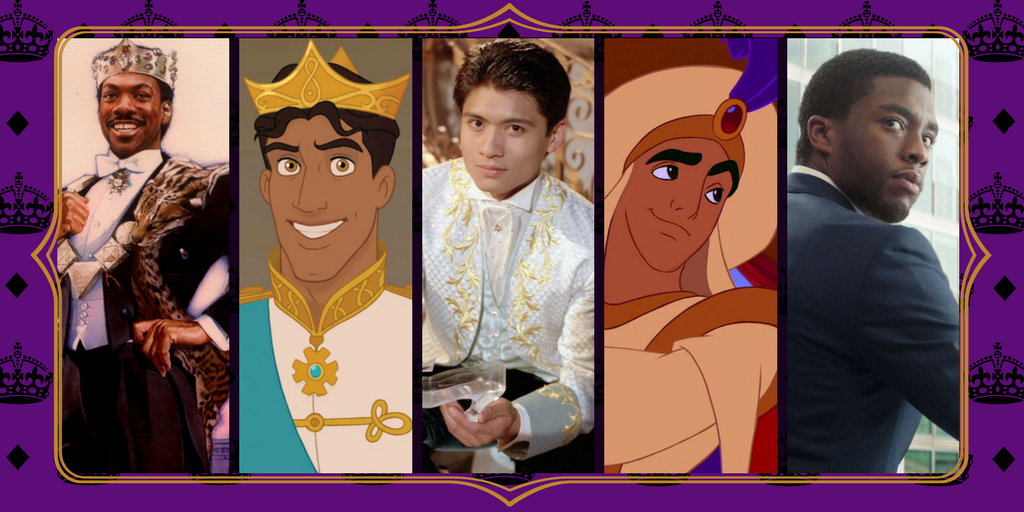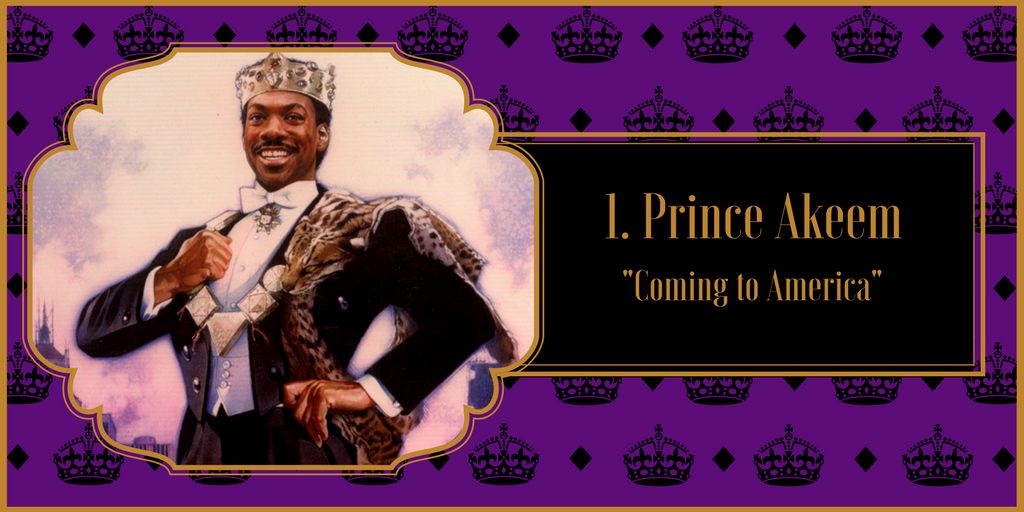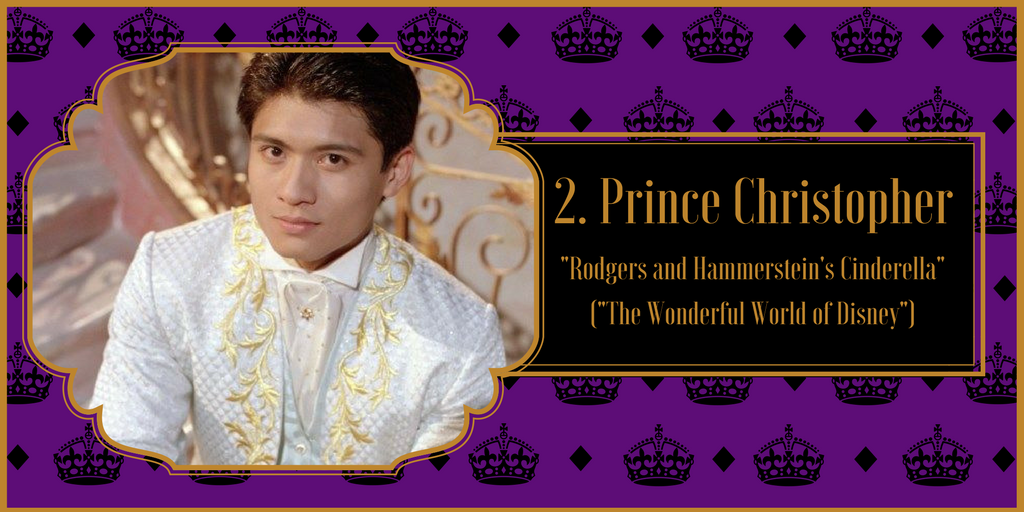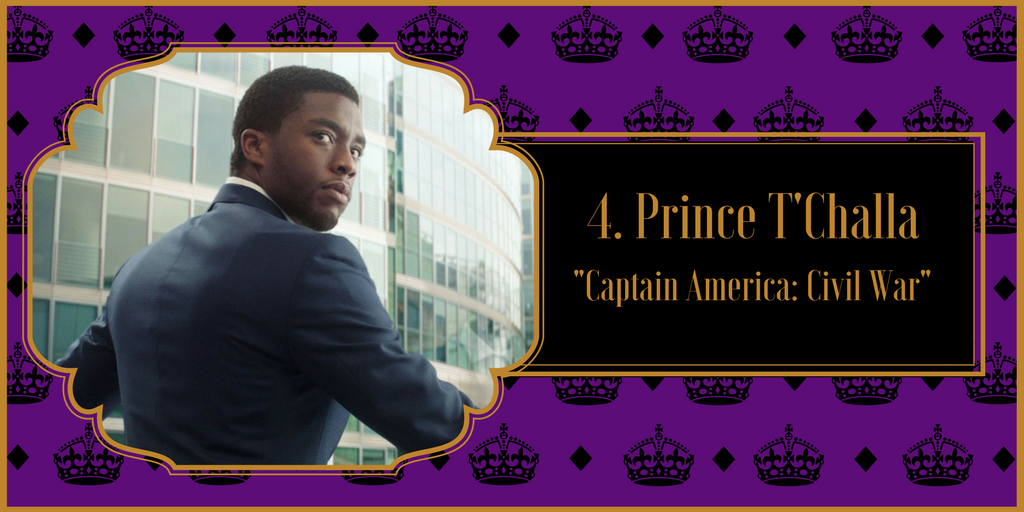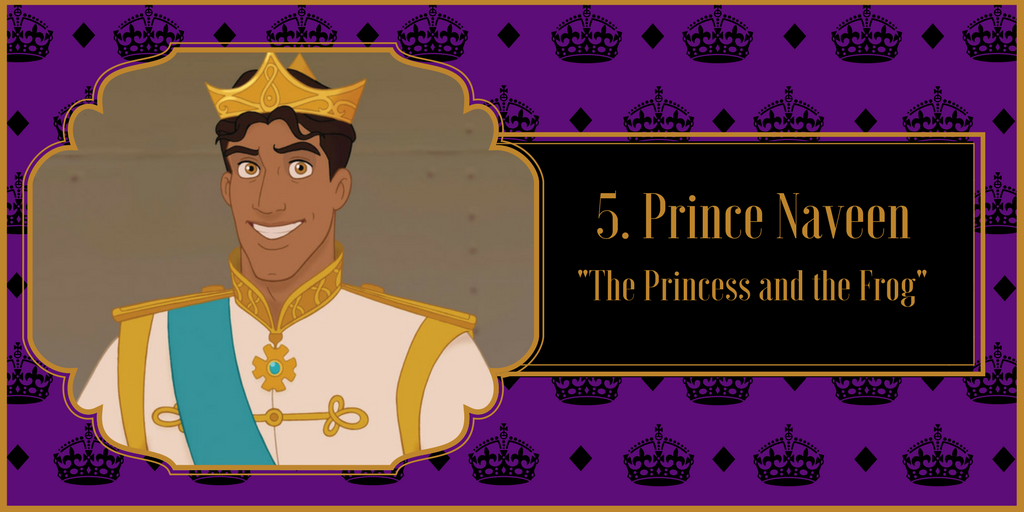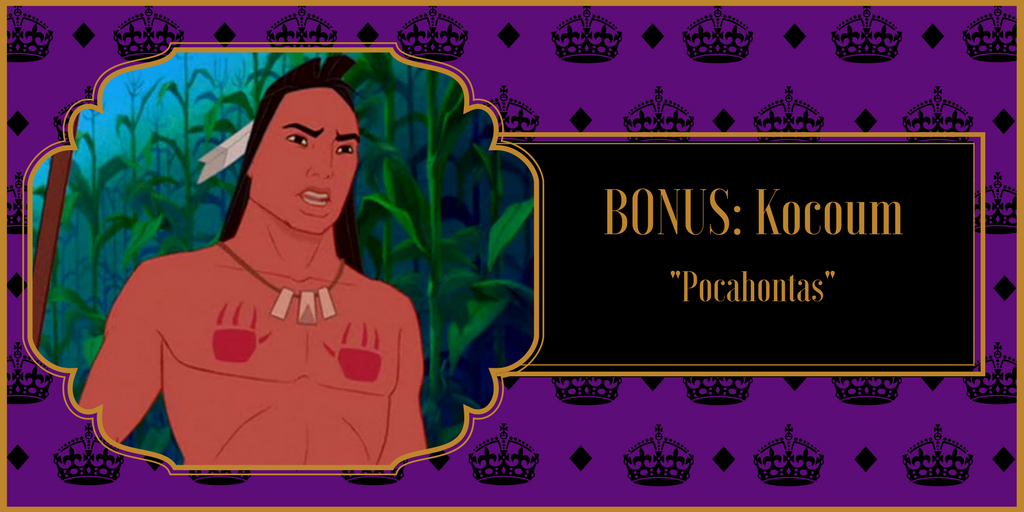Prince Harry and Meghan Markle’s royal wedding is coming, so we’ve been hearing a lot about The People’s Prince. But Prince Harry can take a backseat to these five fictional princes who deserve every moment of recognition they can get. Behold–my list of five princes of color who would be the biggest royal rockstars the world has ever seen if they were real people. Also, there’s one bonus person on this list I just couldn’t leave out.
Technically, Prince Akeem isn’t the first fictional prince I saw as a kid–that would be between Aladdin and the animated Prince Charming. But regardless of when I first saw Coming to America, Prince Akeem is, in my mind, The First Prince. He gets that title in my mental lexicon because he’s the first prince character I saw that stood for something bigger than just royalty. Akeem is part of the royal family of Zamunda, a fictional African country. Even though Zamunda doesn’t exist, it’s the first time I saw Africa represented as something desirable, cool, and fun instead of as a barren wasteland.
Coming to America showed me exactly how awesome Africa actually is, and I wish Africa was showcased as a desirable country more often. Seems like Black Panther has firmly opened the door for that to happen too, since the next project Lupita Nyong’o is taking on is playing the daughter of Viola Davis, and both of them will portray characters based on real life African warriors, the Dahomey Amazons.
Not only is Akeem a benchmark character for Hollywood, but the character is also funny–he’s got to be if he’s the brainchild of Eddie Murphy in his 1980s prime. The character is as hilarious as he is sweet and relatable, and you earnestly want him to get Lisa McDowell (Shari Headley) and triumph over “the prince of Soul Glo,” Darryl Jenks (Eriq La Salle).
When I watched Rodgers and Hammerstein’s Cinderella, I was going through puberty. -End-
You probably need more words than that. Paolo Montalban is the only “Cinderella’s Prince Charming” I need in my life. I don’t even need the prince from Ever After, and that’s one of my favorite Cinderella iterations. Montalban’s Prince Christopher is the ultimate live action Cinderella prince ever. Is it a bold claim? Yes. But it’s a claim I’m willing to assert and argue.
First of all, he’s beautiful and tween me became instantly obsessed. But, if you need some social justice talk to back up my claim of him being the ultimate Cinderella prince, he’s also the only Asian Disney prince ever. Yeah, Li Shang is often put in the “Disney Prince” lineup, but he’s not a prince; he’s a general. The fact that Prince Christopher stands alone in this regard is a crying shame; Disney, you gotta do better than that.
But, Prince Christopher’s presence gives much needed visibility and helps sell Whitney Houston’s vision of a multicultural, multiracial version of this classic story. As a whole, this version of Cinderella means a lot to me, because it was the first time I saw a princess wear braids and be as awkward as I am on a semi-regular basis. Brandy’s Cinderella was just a normal girl (albeit a normal girl in abnormal situations). And because she was so normal and unassuming, it was fantastic for me–someone who was intensely self-hating growing up because I thought I wasn’t the type of girl the hot guys would like–to see someone like Brandy’s Cinderella get a guy as handsom and kind as Prince Christopher. So there you go–that’s what I mean by my statement of watching this during puberty. It wasn’t as dirty as you thought, was it?
Before Prince Christopher came along, my most favorite prince was Aladdin. Yeah, technically, he’s not a prince. But he does pretend to be one when the Genie (Robin Williams, RIP) transforms him into “Prince Ali Ababwa,” a kindly prince that also has enough bravado to take on Jafar and win the heart of Princess Jasmine.
Aladdin has all of the trappings of a great Disney prince; he’s handsome and he’s charming. But unlike a lot of Disney animated princes, he has a tough life, and his hardcore childhood and adulthood left him with extremely low confidence. That’s relatable. As a kid, I would waffle between crushing on Aladdin and mentally urging him to believe in himself in order to get Jasmine (who was so cool to me; she had the greatest hair and a pet tiger and I convinced my mom to name my little sister after her–true story).
Aladdin might also be Disney’s most well-rounded and developed animated princes, since he has a full character arc. Most princes are only there to just be eye-candy, which is something, some could argue, is an inadvertent inversion of stereotypical gender roles. Like, what use does Prince Eric have aside from being a handsome white Aladdin for Ariel to have fantasies about? But Aladdin is so goofy and likable that you end up caring for him just as hard as the Genie does. He’s a good egg, that Aladdin.
When we first meet T’Challa, he’s still a prince under his father King T’Chaka’s wing, much like how Simba is still learning from Mufasa before Mufasa’s untimely death. When T’Chaka’ meets his equally-as-untimely death, T’Challa is left in a limbo, still crowned prince, but is already shouldering the responsibilities of being the new, then-crowned king of his people.
T’Challa is definitely handsome, but what sticks out the most to be about him is how cool he is–both in terms of his gadgetry and in terms of his temperament. T’Challa might be at his coolest in Captain America: Civil War, when he’s out for vengeance. But while he had some awesome lines, such as “I don’t care” when Hawkeye tries to introduce himself, T’Challa’s best moment isn’t about vengeance at all, but about realizing the wisdom of letting his anger dissolve before he committed a crime he would regret. We hardly ever see a hero decide to take the higher road, despite the fact that our heroes are supposed to be frequent higher-road takers.
This is especially true in Civil War, in which everyone is either out for themselves or using others for their own ends (i.e. Iron Man enlisting Spider-Man to fight against the other superheroes despite him being untested and, you know, a kid). While everyone is busy fighting for their own agendas, T’Challa’s storyline of finding who killed his father is one of the few storylines that ring true and honest. (The other storyline that rings true–Iron Man fighting for bureaucracy after coming face to face with the mother of an American who was doing volunteer work in Sokovia.)
Unlike many of his cohorts, T’Challa is wise beyond his years, and that wisdom has served him well during his new tenure as king–it takes the ability of self-reflection to see a villain like Killmonger’s point of view and change your tactics as to how you’re going to govern your nation and act as a beacon to other black diasporic people. Also, now that Marvel is part of Disney, he’s technically Disney’s first black prince. But we could stand to see animated black Disney prince as well. Get on that, Disney.
As far as design goes, Prince Naveen might be one of the most handsome animated Disney princes ever. Yeah, they’re all handsome, but Naveen has a roguish bent to his handsomeness that other animated Disney princes don’t have. On that level, he’s definitely one of the most adult-leaning animated Disney princes, since it’s all too easy to imagine Naveen in some dicey sexual situations. The direction of The Princess and the Frog give hints that Naveen’s a player (or if you want to be really real about it, Naveen’s a whore), but because this is a Disney film, we only get allusions to how Naveen would actually be if this was a PG-13 or R-rated live action version.
(Sidebar: Maybe Tarzan is the only other adult-leaning Disney male character, but not because he’s a player, but because he’s designed explicitly for adult eyes; even though I’m sure women animators being hot and bothered was not an abnormal occurrence at Disney, Glen Keane said in a random interview I watched as a kid how his design for Tarzan had a lot of women animators commenting on how hot Tarzan was and how they’d try to date him if he was real.)
Naveen is definitely the fantasy of “The Tamed Bad Boy” in a Disneyfied package since Tiana, a good girl, ends up being the one to engender some maturity in Naveen and make him see the value in stuff beyond its surface. Of course, is it always good to propel the idea that the woman has to be the mature one that has to grow her man up? No–a woman shouldn’t have to mother their man. But from my point of view, all Tiana is doing is being a good influence on Naveen, and she never really pressures him to change. It’s just through her presence and her convictions about her life path that he realizes he has to grow up to get to her level; never does she reduce herself to succumb to his. I mean, we see Naveen helping Tiana finally achieve her dreams of opening her restaurant, and he’s more than happy to support her. If we can use an adult word like “sexy” with Disney, seeing human Naveen support his wife’s dreams in the film’s ending montage is Naveen at his sexiest point in the movie.
Technically, like Li Shang, Kocoum isn’t a prince. But I also couldn’t justify leaving him out. Whereas Shang has a definite title as General, Kocoum seems to be treated in Pocahontas as something along the lines of a prince. He’s a decorated warrior, and he’s also a respected son of his people and is highly thought of within the community. And, he was betrothed to Pocahontas, the daughter of the chief. To me, he’s more like a warrior-prince than just a standard warrior.
Kocoum is also here because he’s often left off the “Disney Prince” roster, forgotten among Disney’s pantheon of animated leading men. It seems like he’s left off not because he’s dead (unjustly, I might add), but just because he’s a practical, common-sense kind of guy, and what the Magic of Disney doesn’t deal in is practicality and common sense. It’s about the fantasy of love, the fantasy of being a chosen one on a chosen path. Kocoum is already a chosen one in his own right, but he’s also a guy that’s more similar to Tiana in terms of having a 10-year life plan and less like princes like the animated Prince Charming and Aladdin, who rely on magic and pixie dust to achieve their goals. Kocoum knows what he wants his life to be, and he wants to be married to the best pick of the tribe and have kids to ensure his and his wife’s legacies. In other words, he wants to settle down for realistic reasons, making him an Average Joe among the Disney princely set. The movie seems to want to posit that Kocoum wouldn’t be settling down for romantic reasons and that it’s more for duty. But Kocoum never says he doesn’t love Pocahontas! In fact, his actions seem to show that he does indeed care deeply for her. So is Kocoum just being penalized by both Pocahontas and Disney for simply being a regular-degular dude? That’s not fair.
The fact that Kocoum deals in the reality and not in fantasy seems like a poor reason for Pocahontas to just cut Kocoum off from any potential relationship. I mean, can we compare Kocoum and John Smith to see who was the better choice? Yeah, John Smith is aesthetically good-looking, but looks aren’t everything if the soul isn’t there, and John Smith is a terrible person. He was bad in real life, and surprisingly, even Disney couldn’t make John Smith more likable. He’s still a jerk who sneers at Native Americans. Meanwhile, Kocoum, as Pochaontas herself sings about, is someone who could be “a handsome, sturdy husband who build handsome, sturdy walls.” A LOT OF US OUT HERE WANT HANDSOME STURDY HUSBANDS WHO BUILD HANDSOME STURDY WALLS, POCAHONTAS! THAT MEANS THEY’VE GOT THEIR LIVES FIGURED OUT! Kocoum himself said he’d always protect Pocahontas. Pocahontas’ friend Nakoma was forever trying to figure out why Pocahontas wouldn’t just settle down with Kocoum, who is obviously the clear choice. Cut to me as a kid in the theater, trying to figure out exactly what Pocahontas saw in John Smith. Clearly, she’d learned nothing from TLC and chose to chase waterfalls, or in her case, riverbends, and similar to the song, all that came of Pocahontas’ journey was tragedy.
Of course, the real life Pocahontas never had to ponder if she would choose John Smith over Kocoum, since she never chose John Smith in the first place; she was a kid who was used by John Smith in his embellished story about being saved from death by a Native princess. But despite how much I loved the Disney Princess version of Pocahontas, I could never understand why she didn’t just choose Kocoum. What kind of story would we have gotten then? Kocoum would definitely still be alive, sweet little Thomas wouldn’t have had to feel like he had to prove his worth by killing a Native American, and maybe my alternate universe OTP of Thomas and Nakoma could have happened. In any case, I still rep Kocoum all the time, and I only hope this character can get the justice and recognition he deserves.
Loved this article? Follow JUST ADD COLOR at @COLORwebmag and on Facebook! If you want to support more writing like this, donate to my Ko-fi account!
